Yashraj Narang
RobotSmith: Generative Robotic Tool Design for Acquisition of Complex Manipulation Skills
Jun 17, 2025



Abstract:Endowing robots with tool design abilities is critical for enabling them to solve complex manipulation tasks that would otherwise be intractable. While recent generative frameworks can automatically synthesize task settings, such as 3D scenes and reward functions, they have not yet addressed the challenge of tool-use scenarios. Simply retrieving human-designed tools might not be ideal since many tools (e.g., a rolling pin) are difficult for robotic manipulators to handle. Furthermore, existing tool design approaches either rely on predefined templates with limited parameter tuning or apply generic 3D generation methods that are not optimized for tool creation. To address these limitations, we propose RobotSmith, an automated pipeline that leverages the implicit physical knowledge embedded in vision-language models (VLMs) alongside the more accurate physics provided by physics simulations to design and use tools for robotic manipulation. Our system (1) iteratively proposes tool designs using collaborative VLM agents, (2) generates low-level robot trajectories for tool use, and (3) jointly optimizes tool geometry and usage for task performance. We evaluate our approach across a wide range of manipulation tasks involving rigid, deformable, and fluid objects. Experiments show that our method consistently outperforms strong baselines in terms of both task success rate and overall performance. Notably, our approach achieves a 50.0\% average success rate, significantly surpassing other baselines such as 3D generation (21.4%) and tool retrieval (11.1%). Finally, we deploy our system in real-world settings, demonstrating that the generated tools and their usage plans transfer effectively to physical execution, validating the practicality and generalization capabilities of our approach.
DexMachina: Functional Retargeting for Bimanual Dexterous Manipulation
May 30, 2025Abstract:We study the problem of functional retargeting: learning dexterous manipulation policies to track object states from human hand-object demonstrations. We focus on long-horizon, bimanual tasks with articulated objects, which is challenging due to large action space, spatiotemporal discontinuities, and embodiment gap between human and robot hands. We propose DexMachina, a novel curriculum-based algorithm: the key idea is to use virtual object controllers with decaying strength: an object is first driven automatically towards its target states, such that the policy can gradually learn to take over under motion and contact guidance. We release a simulation benchmark with a diverse set of tasks and dexterous hands, and show that DexMachina significantly outperforms baseline methods. Our algorithm and benchmark enable a functional comparison for hardware designs, and we present key findings informed by quantitative and qualitative results. With the recent surge in dexterous hand development, we hope this work will provide a useful platform for identifying desirable hardware capabilities and lower the barrier for contributing to future research. Videos and more at https://project-dexmachina.github.io/
MatchMaker: Automated Asset Generation for Robotic Assembly
Mar 07, 2025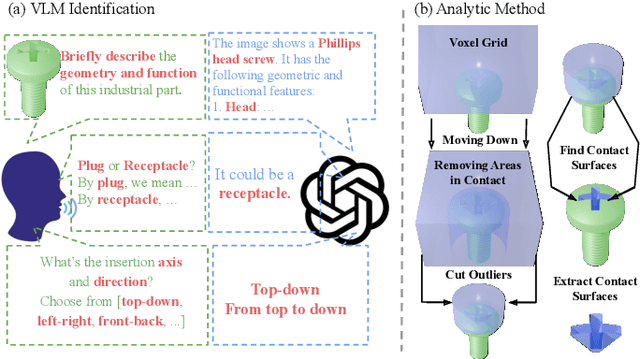
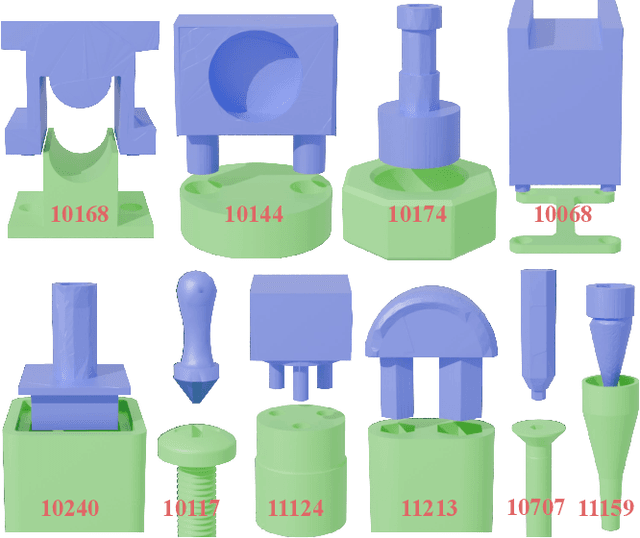
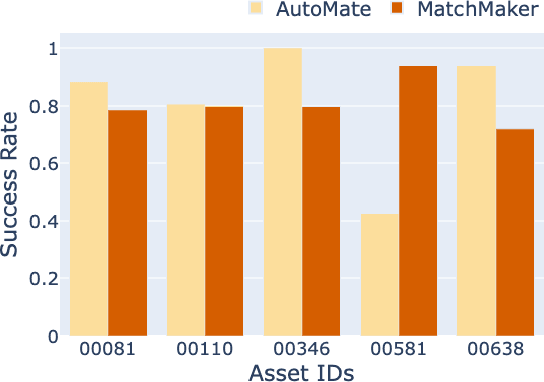
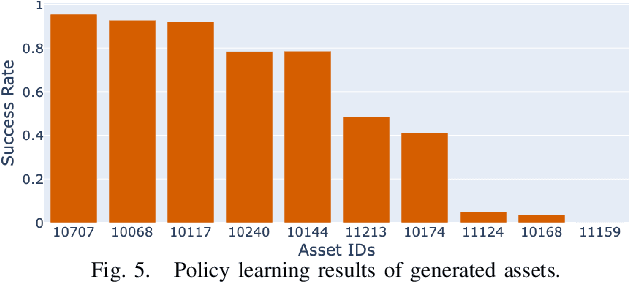
Abstract:Robotic assembly remains a significant challenge due to complexities in visual perception, functional grasping, contact-rich manipulation, and performing high-precision tasks. Simulation-based learning and sim-to-real transfer have led to recent success in solving assembly tasks in the presence of object pose variation, perception noise, and control error; however, the development of a generalist (i.e., multi-task) agent for a broad range of assembly tasks has been limited by the need to manually curate assembly assets, which greatly constrains the number and diversity of assembly problems that can be used for policy learning. Inspired by recent success of using generative AI to scale up robot learning, we propose MatchMaker, a pipeline to automatically generate diverse, simulation-compatible assembly asset pairs to facilitate learning assembly skills. Specifically, MatchMaker can 1) take a simulation-incompatible, interpenetrating asset pair as input, and automatically convert it into a simulation-compatible, interpenetration-free pair, 2) take an arbitrary single asset as input, and generate a geometrically-mating asset to create an asset pair, 3) automatically erode contact surfaces from (1) or (2) according to a user-specified clearance parameter to generate realistic parts. We demonstrate that data generated by MatchMaker outperforms previous work in terms of diversity and effectiveness for downstream assembly skill learning. For videos and additional details, please see our project website: https://wangyian-me.github.io/MatchMaker/.
SRSA: Skill Retrieval and Adaptation for Robotic Assembly Tasks
Mar 06, 2025Abstract:Enabling robots to learn novel tasks in a data-efficient manner is a long-standing challenge. Common strategies involve carefully leveraging prior experiences, especially transition data collected on related tasks. Although much progress has been made for general pick-and-place manipulation, far fewer studies have investigated contact-rich assembly tasks, where precise control is essential. We introduce SRSA (Skill Retrieval and Skill Adaptation), a novel framework designed to address this problem by utilizing a pre-existing skill library containing policies for diverse assembly tasks. The challenge lies in identifying which skill from the library is most relevant for fine-tuning on a new task. Our key hypothesis is that skills showing higher zero-shot success rates on a new task are better suited for rapid and effective fine-tuning on that task. To this end, we propose to predict the transfer success for all skills in the skill library on a novel task, and then use this prediction to guide the skill retrieval process. We establish a framework that jointly captures features of object geometry, physical dynamics, and expert actions to represent the tasks, allowing us to efficiently learn the transfer success predictor. Extensive experiments demonstrate that SRSA significantly outperforms the leading baseline. When retrieving and fine-tuning skills on unseen tasks, SRSA achieves a 19% relative improvement in success rate, exhibits 2.6x lower standard deviation across random seeds, and requires 2.4x fewer transition samples to reach a satisfactory success rate, compared to the baseline. Furthermore, policies trained with SRSA in simulation achieve a 90% mean success rate when deployed in the real world. Please visit our project webpage https://srsa2024.github.io/.
SPOT: SE(3) Pose Trajectory Diffusion for Object-Centric Manipulation
Nov 01, 2024



Abstract:We introduce SPOT, an object-centric imitation learning framework. The key idea is to capture each task by an object-centric representation, specifically the SE(3) object pose trajectory relative to the target. This approach decouples embodiment actions from sensory inputs, facilitating learning from various demonstration types, including both action-based and action-less human hand demonstrations, as well as cross-embodiment generalization. Additionally, object pose trajectories inherently capture planning constraints from demonstrations without the need for manually crafted rules. To guide the robot in executing the task, the object trajectory is used to condition a diffusion policy. We show improvement compared to prior work on RLBench simulated tasks. In real-world evaluation, using only eight demonstrations shot on an iPhone, our approach completed all tasks while fully complying with task constraints. Project page: https://nvlabs.github.io/object_centric_diffusion
One-Step Diffusion Policy: Fast Visuomotor Policies via Diffusion Distillation
Oct 28, 2024



Abstract:Diffusion models, praised for their success in generative tasks, are increasingly being applied to robotics, demonstrating exceptional performance in behavior cloning. However, their slow generation process stemming from iterative denoising steps poses a challenge for real-time applications in resource-constrained robotics setups and dynamically changing environments. In this paper, we introduce the One-Step Diffusion Policy (OneDP), a novel approach that distills knowledge from pre-trained diffusion policies into a single-step action generator, significantly accelerating response times for robotic control tasks. We ensure the distilled generator closely aligns with the original policy distribution by minimizing the Kullback-Leibler (KL) divergence along the diffusion chain, requiring only $2\%$-$10\%$ additional pre-training cost for convergence. We evaluated OneDP on 6 challenging simulation tasks as well as 4 self-designed real-world tasks using the Franka robot. The results demonstrate that OneDP not only achieves state-of-the-art success rates but also delivers an order-of-magnitude improvement in inference speed, boosting action prediction frequency from 1.5 Hz to 62 Hz, establishing its potential for dynamic and computationally constrained robotic applications. We share the project page at https://research.nvidia.com/labs/dir/onedp/.
TacSL: A Library for Visuotactile Sensor Simulation and Learning
Aug 12, 2024



Abstract:For both humans and robots, the sense of touch, known as tactile sensing, is critical for performing contact-rich manipulation tasks. Three key challenges in robotic tactile sensing are 1) interpreting sensor signals, 2) generating sensor signals in novel scenarios, and 3) learning sensor-based policies. For visuotactile sensors, interpretation has been facilitated by their close relationship with vision sensors (e.g., RGB cameras). However, generation is still difficult, as visuotactile sensors typically involve contact, deformation, illumination, and imaging, all of which are expensive to simulate; in turn, policy learning has been challenging, as simulation cannot be leveraged for large-scale data collection. We present \textbf{TacSL} (\textit{taxel}), a library for GPU-based visuotactile sensor simulation and learning. \textbf{TacSL} can be used to simulate visuotactile images and extract contact-force distributions over $200\times$ faster than the prior state-of-the-art, all within the widely-used Isaac Gym simulator. Furthermore, \textbf{TacSL} provides a learning toolkit containing multiple sensor models, contact-intensive training environments, and online/offline algorithms that can facilitate policy learning for sim-to-real applications. On the algorithmic side, we introduce a novel online reinforcement-learning algorithm called asymmetric actor-critic distillation (\sysName), designed to effectively and efficiently learn tactile-based policies in simulation that can transfer to the real world. Finally, we demonstrate the utility of our library and algorithms by evaluating the benefits of distillation and multimodal sensing for contact-rich manip ulation tasks, and most critically, performing sim-to-real transfer. Supplementary videos and results are at \url{https://iakinola23.github.io/tacsl/}.
FORGE: Force-Guided Exploration for Robust Contact-Rich Manipulation under Uncertainty
Aug 08, 2024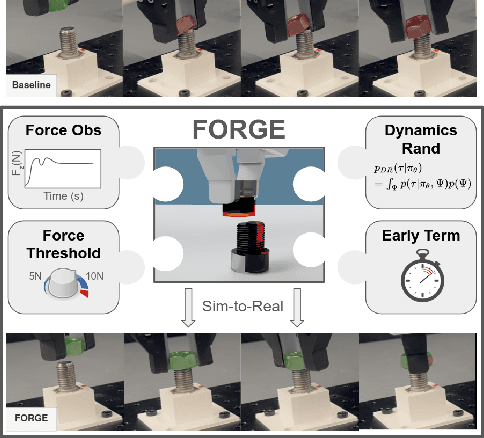

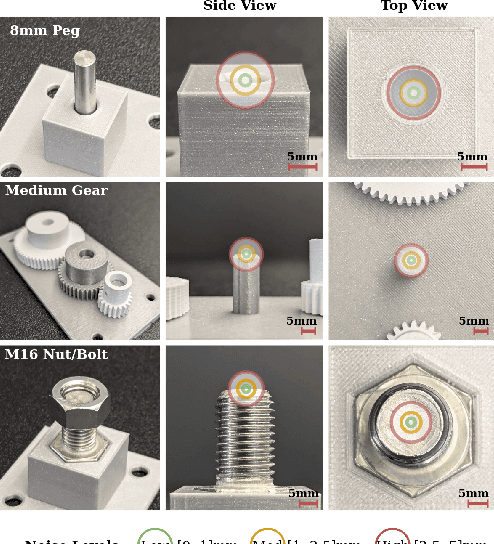
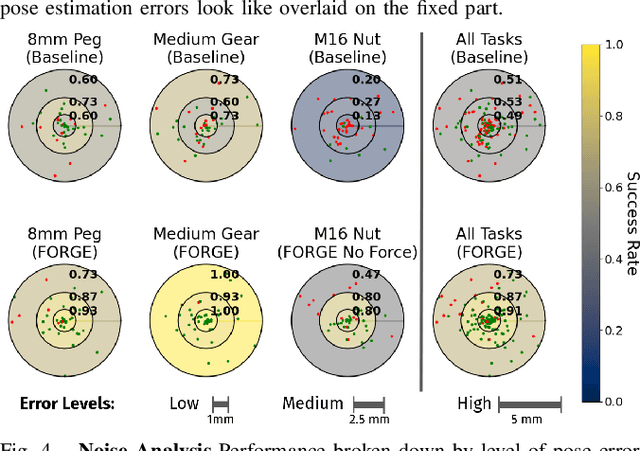
Abstract:We present FORGE, a method that enables sim-to-real transfer of contact-rich manipulation policies in the presence of significant pose uncertainty. FORGE combines a force threshold mechanism with a dynamics randomization scheme during policy learning in simulation, to enable the robust transfer of the learned policies to the real robot. At deployment, FORGE policies, conditioned on a maximum allowable force, adaptively perform contact-rich tasks while respecting the specified force threshold, regardless of the controller gains. Additionally, FORGE autonomously predicts a termination action once the task has succeeded. We demonstrate that FORGE can be used to learn a variety of robust contact-rich policies, enabling multi-stage assembly of a planetary gear system, which requires success across three assembly tasks: nut-threading, insertion, and gear meshing. Project website can be accessed at https://noseworm.github.io/forge/.
AutoMate: Specialist and Generalist Assembly Policies over Diverse Geometries
Jul 10, 2024
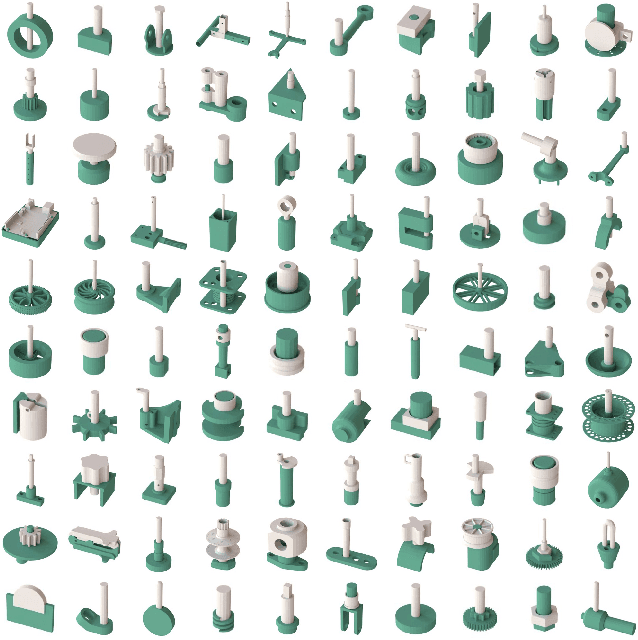
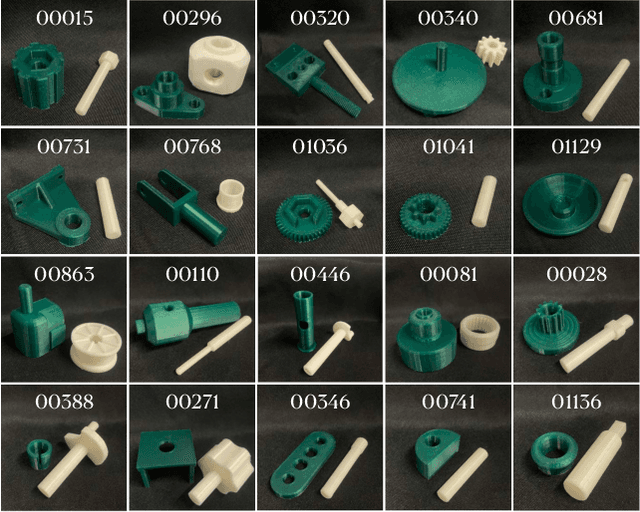

Abstract:Robotic assembly for high-mixture settings requires adaptivity to diverse parts and poses, which is an open challenge. Meanwhile, in other areas of robotics, large models and sim-to-real have led to tremendous progress. Inspired by such work, we present AutoMate, a learning framework and system that consists of 4 parts: 1) a dataset of 100 assemblies compatible with simulation and the real world, along with parallelized simulation environments for policy learning, 2) a novel simulation-based approach for learning specialist (i.e., part-specific) policies and generalist (i.e., unified) assembly policies, 3) demonstrations of specialist policies that individually solve 80 assemblies with 80% or higher success rates in simulation, as well as a generalist policy that jointly solves 20 assemblies with an 80%+ success rate, and 4) zero-shot sim-to-real transfer that achieves similar (or better) performance than simulation, including on perception-initialized assembly. The key methodological takeaway is that a union of diverse algorithms from manufacturing engineering, character animation, and time-series analysis provides a generic and robust solution for a diverse range of robotic assembly problems.To our knowledge, AutoMate provides the first simulation-based framework for learning specialist and generalist policies over a wide range of assemblies, as well as the first system demonstrating zero-shot sim-to-real transfer over such a range.
Scaling Population-Based Reinforcement Learning with GPU Accelerated Simulation
Apr 08, 2024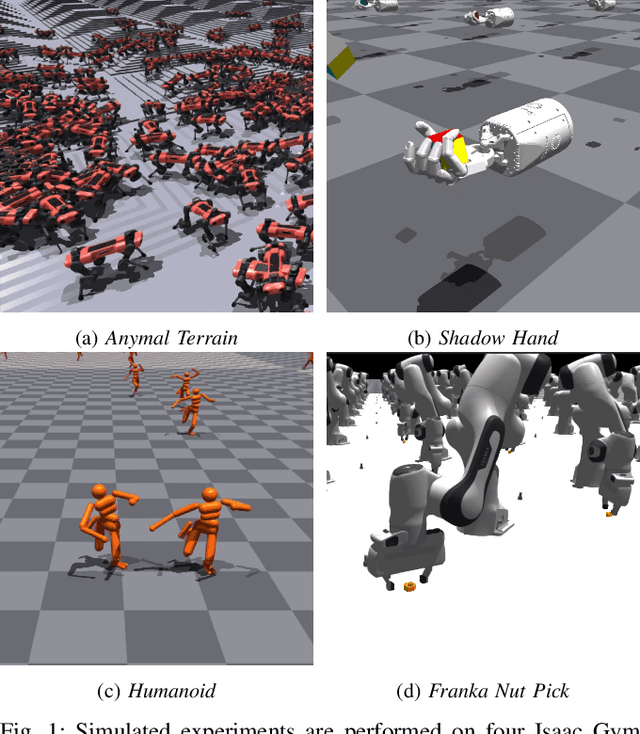
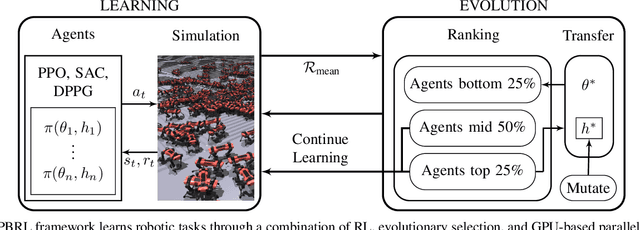
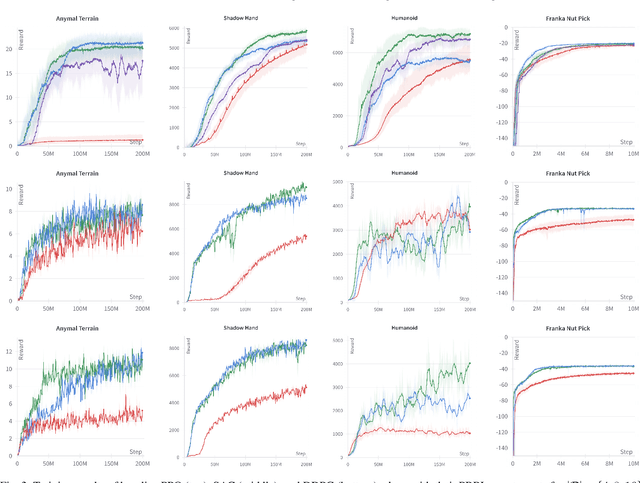
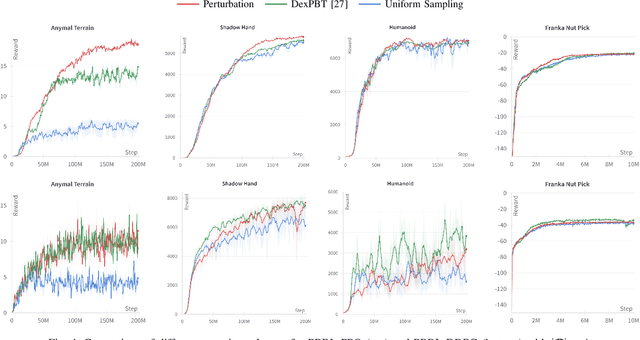
Abstract:In recent years, deep reinforcement learning (RL) has shown its effectiveness in solving complex continuous control tasks like locomotion and dexterous manipulation. However, this comes at the cost of an enormous amount of experience required for training, exacerbated by the sensitivity of learning efficiency and the policy performance to hyperparameter selection, which often requires numerous trials of time-consuming experiments. This work introduces a Population-Based Reinforcement Learning (PBRL) approach that exploits a GPU-accelerated physics simulator to enhance the exploration capabilities of RL by concurrently training multiple policies in parallel. The PBRL framework is applied to three state-of-the-art RL algorithms -- PPO, SAC, and DDPG -- dynamically adjusting hyperparameters based on the performance of learning agents. The experiments are performed on four challenging tasks in Isaac Gym -- Anymal Terrain, Shadow Hand, Humanoid, Franka Nut Pick -- by analyzing the effect of population size and mutation mechanisms for hyperparameters. The results show that PBRL agents achieve superior performance, in terms of cumulative reward, compared to non-evolutionary baseline agents. The trained agents are finally deployed in the real world for a Franka Nut Pick task, demonstrating successful sim-to-real transfer. Code and videos of the learned policies are available on our project website.
 Add to Chrome
Add to Chrome Add to Firefox
Add to Firefox Add to Edge
Add to Edge